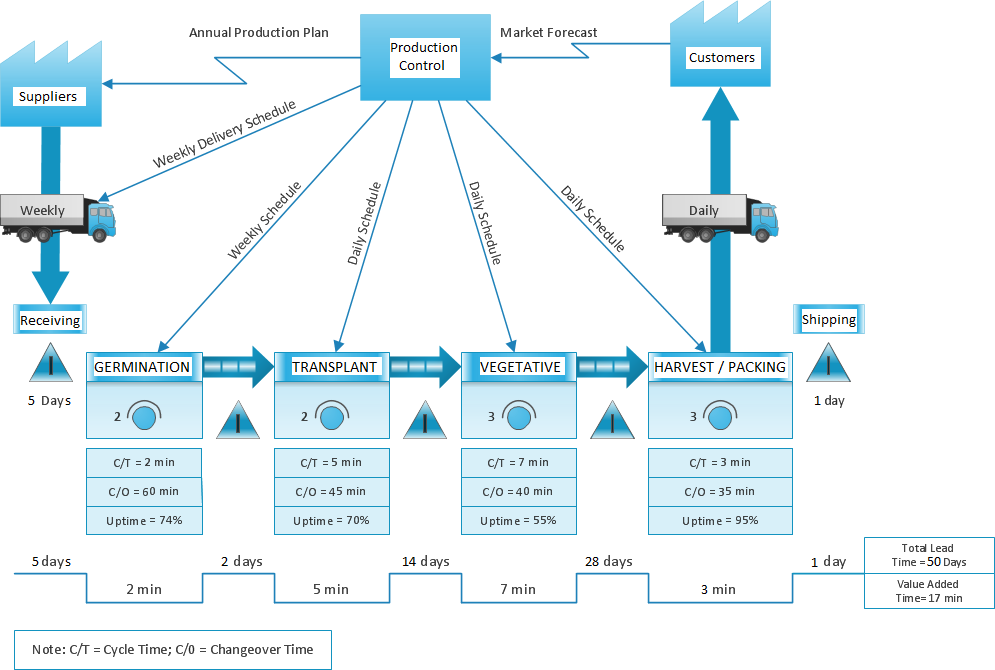As we delve further into the 21st century, vertical farming technology has seen significant advancements, specifically in the cultivation of lettuce in high-tech greenhouses. Leveraging advanced equipment such as hydroponics, LED lighting, and climate control systems, these facilities have been able to grow lettuce year-round, regardless of external weather conditions. However, the question of efficiency remains. Value Stream Mapping (VSM) is a key to unlocking the full potential of these cutting-edge facilities.
Understanding High-Tech Lettuce Greenhouses
High-tech lettuce greenhouses operate using a combination of cutting-edge technologies. Hydroponic systems replace traditional soil with nutrient-rich water solutions, facilitating controlled nutrient uptake and faster growth rates. LED lighting offers adjustable light spectrum and intensity to suit the needs of lettuce at different growth stages. Automated climate control systems maintain optimal temperature, humidity, and CO2 levels for lettuce cultivation. This level of control allows for year-round production of high-quality lettuce, but the complexity of these systems can also lead to inefficiency if not properly managed.
Applying Value Stream Mapping to High-Tech Lettuce Greenhouses
Given the advanced technologies at play in these facilities, VSM’s role becomes vital in ensuring optimal utilization of resources and maximized yields. The process remains as defined in my previous article, but let’s take a look at how each step can be customized for high-tech lettuce greenhouses:
Step 1: Define the Process
Our process begins with the preparation of the hydroponic system for planting and ends with the packaged lettuce leaving the facility for distribution.
Step 2: Create a Current State Map
Each step in the process is carefully documented, considering the resources utilized and the time taken. For instance, you might record the specifics of nutrient solution preparation, plant spacing in the hydroponic system, the calibration of LED lights, climate control settings, harvesting procedures, and post-harvest handling.
Step 3: Analyze and Identify Waste
Through thorough analysis, potential areas of waste are identified. For instance, if the LED lights are not properly calibrated to the growth stage of the lettuce, they might consume more electricity than necessary, leading to energy waste.
Step 4: Envision a Future State Map
Based on our findings, a future state is conceived where waste is minimized or eliminated. Perhaps the LED light calibration could be optimized with AI algorithms adjusting light spectrum and intensity in real-time based on the plant’s growth stage, reducing energy consumption.
Step 5: Develop an Action Plan
The future state map provides a roadmap for improvements. An action plan might include upgrading to an AI-driven lighting system, retraining the staff on the new system, and tracking the subsequent improvements in energy usage.
The Impact of VSM on High-Tech Lettuce Greenhouses
Applying VSM to high-tech lettuce greenhouses can yield remarkable results. By identifying and minimizing waste, resource efficiency is significantly improved, leading to cost savings. A facility that uses less electricity and water without sacrificing yield is not only more sustainable but also more profitable.
Beyond resource use, VSM can also enhance productivity. By streamlining processes, we can increase the yield per square foot of greenhouse space. This results in higher profits, making the venture more attractive to investors.
Furthermore, improving the process transparency enhances quality control. This is particularly important for high-tech lettuce greenhouses, where the consistency and quality of the produce can directly influence market acceptance.
Conclusion
The integration of Value Stream Mapping into high-tech lettuce greenhouses can lead to substantial improvements in efficiency, sustainability, and profitability. By utilizing this lean management tool, we can harness the full potential of our advanced farming technologies while minimizing waste and optimizing resource usage.
Moreover, by improving transparency, we can better understand the intricate interplay of variables within the greenhouse. This insight not only assists in troubleshooting issues but also paves the way for innovation. For instance, it might reveal opportunities to fine-tune our nutrient solutions or lighting schedules to boost growth rates, or it could highlight areas where automation could further streamline operations.
The potential of VSM goes beyond immediate cost savings. As we continually refine our processes, we’ll also enhance the sustainability of our operations. Vertical farming already offers substantial environmental benefits, such as reduced land use and water consumption, and increased local production reducing food miles. By further optimizing our resource use through VSM, we can make our lettuce greenhouses even more eco-friendly, contributing to a more sustainable food future.
From a market perspective, optimizing high-tech lettuce greenhouses through VSM can enhance product quality and consistency, giving consumers a reliable supply of premium lettuce year-round. This could lead to increased market share, strengthening the position of vertical farming within the agriculture sector.In conclusion, integrating Value Stream Mapping into high-tech lettuce greenhouses promises significant benefits. As we continue to advance vertical farming technologies, VSM provides a robust framework to ensure we fully leverage these innovations, driving efficiency, sustainability, and profitability in our operations.

